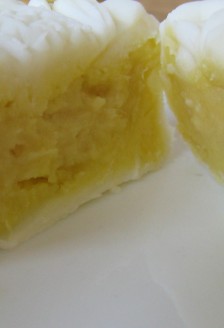Mid-Autumn Festival: Moon cake mania!
Mini moon cakes, traditional White Lotus Seed paste and snow skin from Pine House Bakery, St. Germaine Bakery and T&T Supermarket, Metrotown, Burnaby, BC
Legend has it that on the day of the Mid-Autumn Festival (the 15th day of the 8th month on the Chinese Lunar year calendar), when the moon is at its fullest, you can catch a glimpse of Chang Er, floating across the moon. Chang Er was the wife of a gifted archer in Chinese mythology, Hou Yi. In the legend, on the day that ten blazing suns rose to the sky, Hou Yi used his archery skills to shoot down nine of those suns with arrows to save the earth from being scorched. But later on, when Chang Er drank an elixir that granted immortality, she floated to the moon and Hou Yi loved her too much to shoot his arrows at her. So once a year in Mid-Autumn, Chang Er can be found floating across the pure, bright white surface of the full moon.
In Asian cultures across the world, the Mid-Autumn Festival has been celebrated for over 3,000 years. The Festival marks a time of harvest and family gatherings. In Hong Kong, the Mid-Autumn Festival is a statutory holiday. The festival is a time when families gather together to light lanterns, eat moon cakes, fresh fruit, and observe the full moon, and maybe catch a glimpse of Chang Er as she wanders across the moon, forever waiting for her beloved husband.
Traditional White Lotus Seed Paste moon cake, Pine House Bakery, Crystal Mall, Burnaby, BC
The Mid-Autumn festival is also known as Moon Cake festival. These little cakes are only available once a year during the festival and are traditionally made of a buttery, sweet chewy crust and filled with sweet white lotus seed paste. A salted duck egg yolk is found in the center of the cake- this bright, round orange yolk represents the full moon. These traditional moon cakes are sweet and salty, and filling which is perfect for the cooler autumn nights. Although, personally, I don’t like the egg yolk in the middle. I prefer my moon cakes moon-less; I like to bite into one big mouthful of sweet and sticky white lotus seed paste and feel it stick to the roof of my mouth and the sides of my cheeks as I chew.
White Lotus Seed Paste moon cake with salted egg yolk, Pine House Bakery, Crystal Mall, Burnaby, BC
Other traditional and equally scrumptious moon cake fillings include sweetened mung bean paste, red bean paste and winter melon. Moon cake fillings have evolved tremendously over the years and now include harvest season fruits, berries, and even higher end fillings such as shark fin. The preserved shark fin and nut fillings give the moon cake much more texture since the nuts provide crunch and the preserved shark fin enhances the saltiness in the salted egg yolk.
Shark fin and nut filling moon cake, Maxim Bakery, Metrotown, Burnaby
Not only have moon cake fillings evolved but moon cake crusts have also taken new and more delectable forms such as the now ever popular snow skin moon cakes. These little cakes are made with glutinous rice crusts and come in all sorts of pastel colours and shapes, moving away from the traditional golden brown crusts of baked moon cake. These little snow skin moon cakes are as pretty as Petite Fours and taste even better: what they lack in icing, they make up for in a wide variety of fillings!
Chocolate moon cake, Pine House Bakery, Crystal Mall, Burnaby, BC
Snow skin moon cake fillings can include either mung bean, red bean or even all sorts of fruits from mango, strawberries and cream cheese to the smelly but velvety soft durian. There are even chocolate snow skin moon cakes with a single round chocolate truffle in the center to represent the full moon. Snow skin moon cakes are definitely more accessible to the general public, and also opens up the possibilities of incorporating contemporary ingredients into a traditional treat. Snow skin moon cakes are eaten cold, and there’s nothing like biting into an ice cold, sweet and chewy snow skin moon cake with a steaming hot cup of Jasmin tea in hand. That’s when I know autumn is here.
Durian moon cake, St. Germaine Bakery, Metrotown, Burnaby, BC




One Response to Mid-Autumn Festival: Moon cake mania!
chris
on September 22, 2010
Reply
Chocolate Moon Cake, miam miam.
Happy mid autumn festival